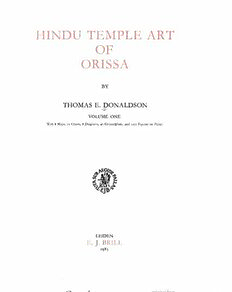Table Of Content1-IINDU Tfi i\IPJ_J E 1\R T
OF
ORISS £\
BY
THOMASE. DONALDSON
--:::-
VOLUME ONE
\'(11th S ~laps. 1z Charis, 8 Diagram~. 40 Groundplans, :and 1:57 f1~urcs on Pl:a1cs
LEIDEN
l .. J.BRIJ I.
1981
Google Original from
oigitized by UNIVERSITY OF MICHIGAN
STUDIES
IN
SOUTH ASIAN CULTURE
EDITED BY
JANICE STARGARDT
VOLUME XII
THOMASE.DONALDSON
HINDU TEMPLE ART OF ORISSA
VOLUME ONE
LEIDEN
J.
E. BRILL
1981
Google Original from
oigitized by
UNIVERSITY OF MICHIGAN
-
.
,-~-.
gle
GOl •
t.,.
01g1tized . • .
u ,/. '' .I , I -• I 1
~ ~ "'-
~ ' ' ' r fGAN
Go gle ongmal from
01g1tized b UNIVERSITY OF MICHIGAN
The publication of this work was made possible by grants from National Endowment
for the Humanities and the Millard Meiss Fund. Field research was panially funded by a
Bingham Fellowship from Case-Western Reserve University in 1970 and by grants from
Cleveland Stare University awarded in 1976, 1978 and 1983.
ISBN ?O 04 0111J '
9004071741
J'
CoP.J'Ttght 1911 by E. ] . Brill, Ltititlf, Tht 1tJhtrlonds
All n~hts rtJtrPtd. No f>drl o/ t/Jit book. 11111) bt rrprl>d11rrd ()r
•
lraJU/aJrd in ""Y Jorl'll, ~print, pbotopri1't, 111irrofilm, 1111irrofirht
or "".l otbtr 111ra111 •ilho111 .,,;,,,,, ptr•1Jsut11 fro• 1hf p-.!Jl11htr
Google Original from
oigitized by UNIVERSITY OF MICHIGAN
-
To "'J thildrtn
Ktvin, SbaMna and Dtirdrt
Got g le On91nal from
0191t1zed by UNIVERSITY OF MICHIGAN
Go gle onginal from
0191t1zed b, UNIVERSITY OF MICHIGAN
EDITOR'S PREFACE
It is a sad duty to begin this preface with the death of the late Professor
J.
E. van Lohuizcn-de Leeuw, sometime Director of the Institute of South Asian
Archaeology, University of Amsterdam, which occurred suddenly in December 1981.
Professor van l ohuizen's numerous services to the study of the art history and archaeolog)'
of South and South East Asia arc well known; not the least of them was her work as
founder and first editor of the present series, S111dit1 in So11th Asian C11//11rt. This volume is
the twelfth to appear since the series began in 1969. The coverage is wide, as befits the
series title, and has included volumes on the prehistoric archaeology of India and Indonesia
alongside those devoted to the architectural and art history of India and Sri Lanka. As well
as serving as indispensable sources for scholars working in those fields, the volumes are
regularly consulted by those in the cognate fields of historical archaeology, epigraphy,
ancient and mediaeval history and cultural anthropology.
J.
In accepting the invitation extended to me by E. Brill to assume the editorship of
this stries, togothcr with the Archaeology and Art History stries of the Handb11rh der
Orirntali11ile, I am sensible of the honour and the responsibility involved, and of the
ineluctable fact that to continue it in the creari,•c sense means, not to repeat. but to rcnc~·
the series by looking at manuscripts from the whole range of disciplines mentioned above,
all of which belong to South Asian cultural studies, in addition to the areas of the series'
traditional strengths.
Dr Thomas Donaldson's exhaustive study of Hind11 Temple Art of Oriua, will appear in
three volumes which together form Volume XII of the series. In Volume I, presented here,
he undertakes an illuminating analysis of the temple architecture of Orissa, drawing into his
scrutiny many structures that have not prC\•iously received systematic study and at the same
time using a set of organizing principles that arc solidly based on the evidence presented by
the temples themselves. This procedure attemprs to reduce the chronological uncertainties
surrounding inscriptions, rcgnal dares and the associations <)f monuments with rulers.
Instead, he looks at the internal evidence of the monuments to trace an Orissan stylistic
vocabulary whose significant changes have chronological as well as regional connotations.
Though beginning as early as the sixth century, the study is principally concerned- in this
volume-with temples of the eighth and ninth century and the tenth and eleventh century.
Further development is followed up to the twelfth century in this volume and post-twelfth
century in Volume II. Dr Donaldson's monographs had already been accepted for
publication in this series by Professor van Lohuizen before her death. It is therefore
appropriate to conclude with her evaluation of them:
"From what I have read, I was deeply impressed by the high quality of this piece of
research. To say that it is a good book would be a monumental understatement, fur it
is in every way exemplary and one would wish that similar books were available for
the other styles of Indian an, which unfortunately is not the case. If this manuscript
could be published, it would be the first real handbook on anr style of Indian
architeeturc and would serve as an example for others to follow".
Google Original from
01gitized by UNIVERSITY OF MICHIGAN
\'111 l~l>rrclR'S PR.l~f:\<:I~
I am glad to be associa1ed with the publication of Dr Donaldson's studies, albeit at a late
s<age of the production of the first volume. I should like to take this opponunit)' to express
my gratitude and that of the publishers to the following foundations for the financial
suppon needed for the production of a work like this: The National Endowment for the
Humanities; the Millard Meiss Fund.
J..
,~1c:1.~ ST,\R<;;\ Rl'lT
Dirrctor,
Cambridge Project on Ancient Civilization
Cambridge, Winter 1981 in South East Asia
Google Original from
oigitized by
UNIVERSITY OF MICHIGAN

